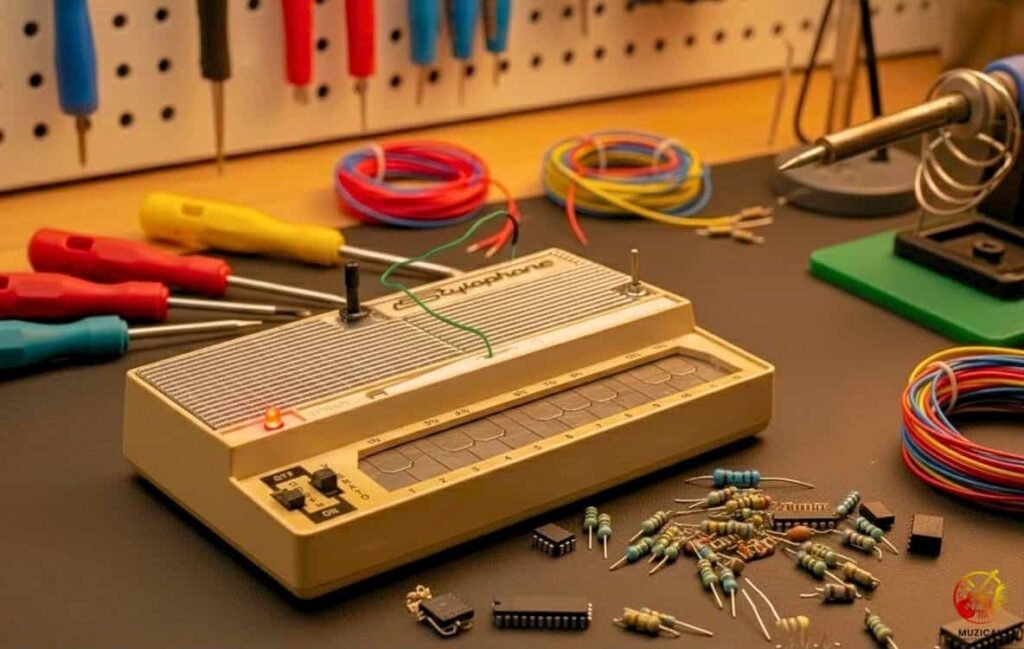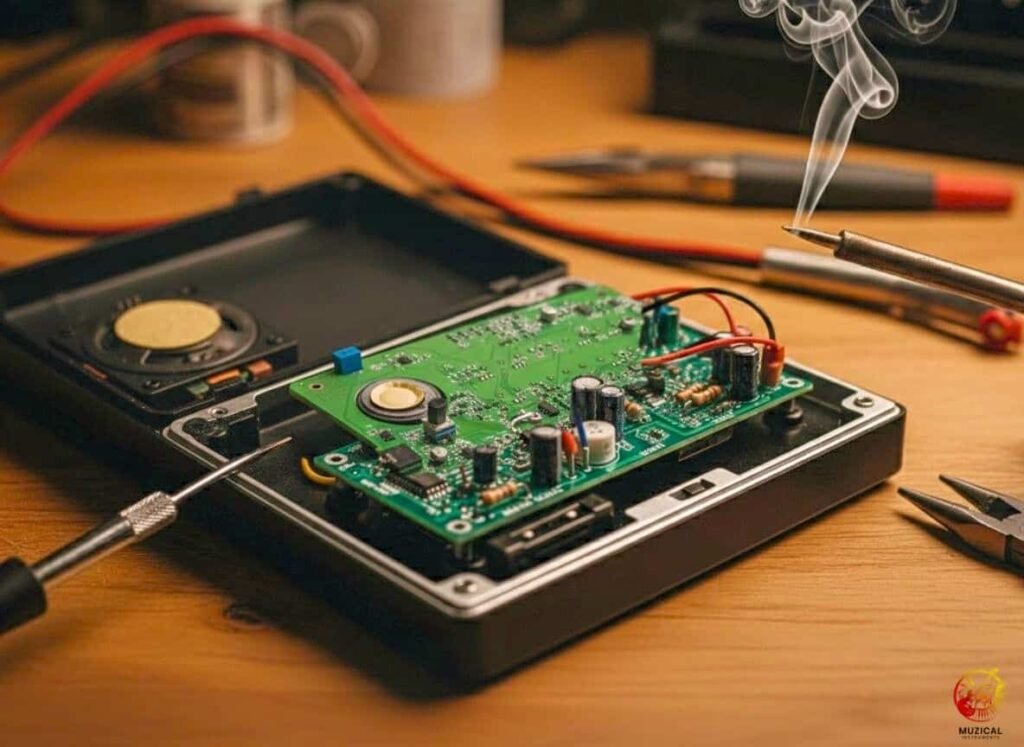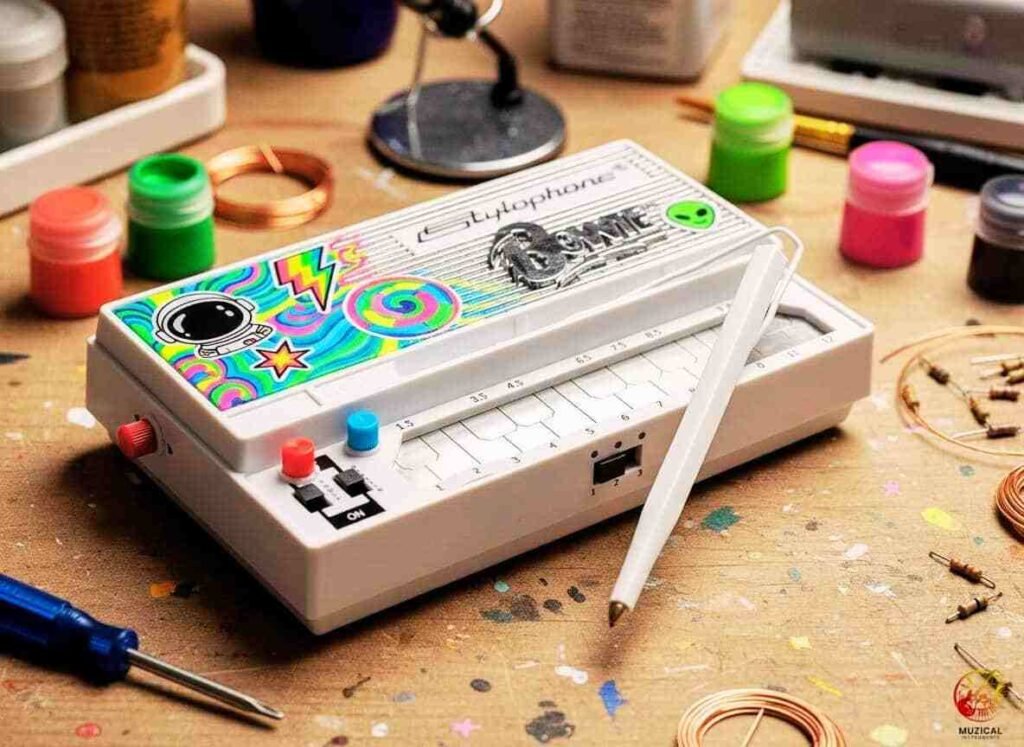What Cool DIY Mods on a Stylophone You Can Try?
The Stylophone is a cool little pocket synthesizer with a unique buzzing sound. But did you know you can do some amazing DIY mods on a Stylophone to completely change how it sounds and works?
It’s true! You can take this simple instrument, first made famous by Dubreq in the ‘60s, and turn it into something much more powerful.
This guide will walk you through all kinds of fun projects, from easy first-time tweaks to more advanced electronic changes. You’ll learn how to unlock new sounds, understand what makes these modifications work, and get ready to start your own Stylophone customization journey. Let’s make your instrument one-of-a-kind!
What are the best DIY mods on a Stylophone for beginners?

If you’re new to tinkering with electronics, it’s smart to start with simple projects. One of the easiest and most useful mods is adding an output jack. Your Stylophone has a tiny speaker, but an output jack lets you plug it into a guitar amp, cool effects pedals, or your computer for recording.
Suddenly, you can make your Stylophone sound huge with reverb or gritty with distortion. You just need an audio jack, a soldering iron, and some wire to tap into the audio signal on the circuit board.
Another great beginner mod is to replace the built in speaker. The one it comes with is basic, but upgrading to a slightly better one can make your Stylophone sound clearer and louder. It’s a quick fix that makes a noticeable difference. These simple DIY mods on a Stylophone are a perfect entry point into electronic customization.
| Mod Name | Difficulty | Tools Needed | Time to Complete | What It Does |
|---|---|---|---|---|
| Audio Output Jack | Easy | Soldering iron, drill, audio jack | 30-60 minutes | Lets you plug into amps & pedals |
| Speaker Upgrade | Easy | Screwdriver, soldering iron | 20-40 minutes | Makes the built-in sound better |
| Vibrato Speed Knob | Medium | Soldering iron, potentiometer | 1-2 hours | Gives you control over the wobble effect |
Pro Tip: When you’re soldering on a small Printed Circuit Board (PCB) like the one in a Stylophone, be quick! Holding the hot iron on one spot for too long can damage components.
How can I add cool effects to my Stylophone?
Ready for the next step? You can add effects and controls right into the Stylophone’s body. A great one to try is a filter knob. The Stylophone has a very bright, buzzy tone. A simple low pass filter (LPF) lets you roll off those high frequencies, making the sound warmer and softer. With a single knob, you can sweep from a bright “bzzz” to a deep “booo,” which adds a lot of expression.
You can also add a pitch bend. The Stylophone plays fixed notes, but adding a pitch bend wheel or knob lets you bend notes up or down, just like on a big synthesizer. This adds personality to your playing and usually involves adding a potentiometer into the part of the circuit that controls pitch. For a bigger project, you could even build a small distortion or delay circuit and stick it right inside the case.
What is circuit bending a Stylophone all about?

Now we’re entering the wild side of instrument modification: circuit bending. This is an experimental approach to DIY mods on a Stylophone.
The idea is to poke around the circuit board and intentionally connect points that were never meant to be connected, resulting in strange, wonderful, and unpredictable new sounds. You might find glitches, sci-fi noises, or robotic rhythms. It’s like a sonic treasure hunt.
A common circuit bending trick is adding “body contacts.” These are small metal screws connected to different points on the circuit. When you touch them, your body’s electricity changes the sound, giving you hands on control over the glitches.
Another fun idea is to use a light dependent resistor (LDR), a tiny electronic eye that changes the sound based on how much light hits it. Wave your hand over it, and you can create a theremin like effect. Circuit bending can be risky, but it’s the source of the most unique sounds you can get from this analog synth.
| Circuit Bending Mod | What It Is | What It Sounds Like | Risk Level |
|---|---|---|---|
| Body Contacts | Metal pads you touch to alter the circuit | Glitches, pitch dives, weird rhythms | Medium |
| LDR (Light Sensor) | An "electric eye" that controls a parameter | Pitch changes when you wave your hand | Medium |
| Glitch Switch | A switch that connects two random points | Turns on a specific glitch or crash sound | High |
Expert Insight: When circuit bending, use alligator clips to test connections before soldering anything. This lets you explore safely and find the coolest sounds first.
Can I change how my Stylophone looks and feels?

Absolutely! Many DIY mods on a Stylophone are all about making it look cooler and feel better to play. The plastic case is iconic, but you could build a brand new one out of wood, clear acrylic, or 3D print a custom design.
This lets you create a personal instrument and gives you more space for new knobs and switches. It involves taking the Stylophone apart and carefully moving the electronics into the new case.
You can also upgrade the stylus with a more comfortable handle or even replace the metal keyboard with larger, custom-made touch pads. These physical modifications are all about making the instrument a better fit for you.
What are some advanced ways to get new sounds?
If you’re comfortable with the basics, advanced electronic DIY mods on a Stylophone can completely transform its sound. One great mod is to add a sub oscillator. This is a second sound source that plays a note one octave below the main one, making the sound much deeper and fatter.
Another powerful project is adding a simple envelope generator (ADSR). Instead of notes just being “on” or “off,” an envelope lets you control how a sound starts and ends. You could make notes fade in slowly or have a long, echoing tail after you lift the stylus. This turns the Stylophone into a much more expressive synthesizer.
How do I connect my modded Stylophone to other gear?
Once you’ve done a few DIY mods on a Stylophone and added an audio output, you can connect it to other music gear. The most obvious step is plugging it into guitar effects pedals.
The buzzy tone sounds amazing through distortion, delay, and reverb. You can create everything from heavy rock riffs to spacey ambient textures.
For more advanced setups, you can add features to sync its LFO (the vibrato effect) to the tempo of your drum machines.
The ultimate integration project is adding MIDI capability, which lets you play your Stylophone from a keyboard or computer. This turns your little modded instrument into a serious player in a modern music setup.
What should I know about safety before I start?
Safety first! Even with a battery powered device, be careful during any DIY mods on a Stylophone.
- Always take the batteries out before you open the case.
- Work in a well ventilated area if you are soldering to avoid fumes.
- Wear safety glasses to protect your eyes from flying debris or solder.
- Double check your wiring before putting the batteries back in to prevent shorts.
- Be careful when drilling new holes so you don’t damage the circuit board.
- Take your time. Rushing leads to mistakes. Modding should be fun!
Final Thoughts
Tackling DIY mods on a Stylophone is a fantastic way to learn about electronics while creating a musical instrument that is totally your own.
We’ve seen how you can start with simple projects like an output jack and then move on to wilder things like circuit bending or adding new effects. Each modification gives you more sonic tools to play with, turning a simple pocket synth into a source of endless creative sounds.
The journey from a standard Stylophone to a personalized music machine is incredibly rewarding.
So, don’t be afraid to get out your soldering iron and see what strange and wonderful noises you can unlock. What will your first Stylophone mod be?
FAQ: What Cool DIY Mods on a Stylophone You Can Try?
1. What’s the easiest DIY mod for a Stylophone?
The easiest and most popular mod is adding an audio output jack. This lets you connect your Stylophone to external gear like amplifiers, speakers, or effects pedals. It only requires basic soldering skills and is a great first project for beginners.
2. Can you connect a Stylophone to a guitar amp?
Yes! Once you’ve added an audio output jack, you can easily connect your Stylophone to any standard guitar amplifier. This is a fantastic way to make your Stylophone much louder and shape its tone using the amp’s controls.
3. What kind of effects pedals work well with a Stylophone?
The Stylophone’s simple, buzzy tone sounds great with many types of effects pedals. Distortion and fuzz pedals can add a heavy, aggressive edge, while delay and reverb pedals can create spacey, atmospheric soundscapes. A wah pedal can also produce some very cool vocal-like sounds.
4. How do you add a pitch bend to a Stylophone?
Adding a pitch bend usually involves soldering a potentiometer (a variable resistor, or knob) into the part of the Stylophone’s circuit that controls its pitch. By turning the knob, you change the resistance, which makes the pitch go up or down, allowing for more expressive playing.
5. Is it hard to circuit bend a Stylophone?
Circuit bending can be easy to start but difficult to master. The basic process of connecting random points with a wire to find new sounds is simple and requires no prior knowledge. However, to create stable and controllable DIY mods on a Stylophone from your discoveries, you’ll need some soldering skills and a willingness to experiment.
6. Can I make my Stylophone sound better without major mods?
Yes. One of the simplest ways to improve the sound is to upgrade the built-in speaker. Replacing the small, stock speaker with a slightly higher-quality one of the same size can increase clarity and volume, making the instrument sound fuller without changing its core circuitry.
